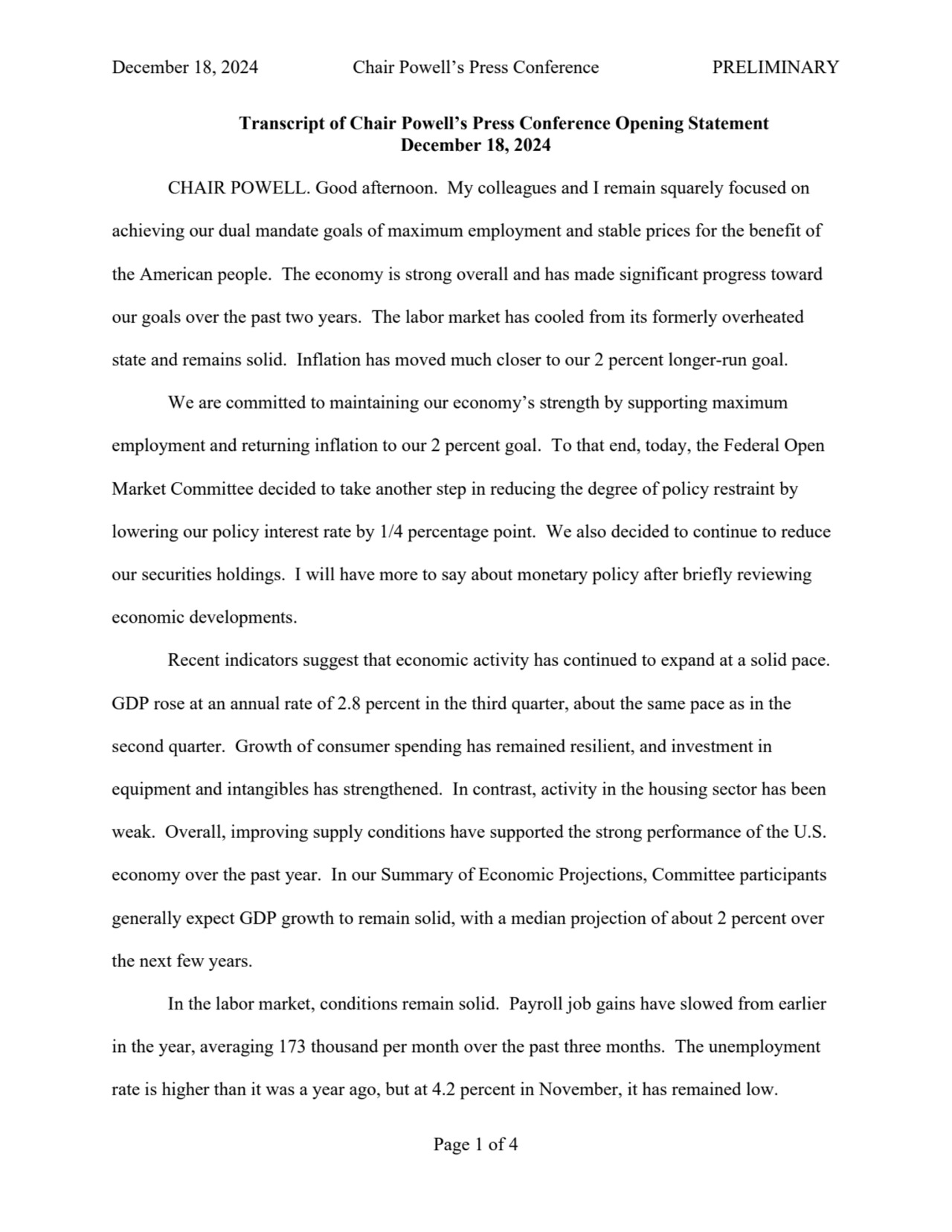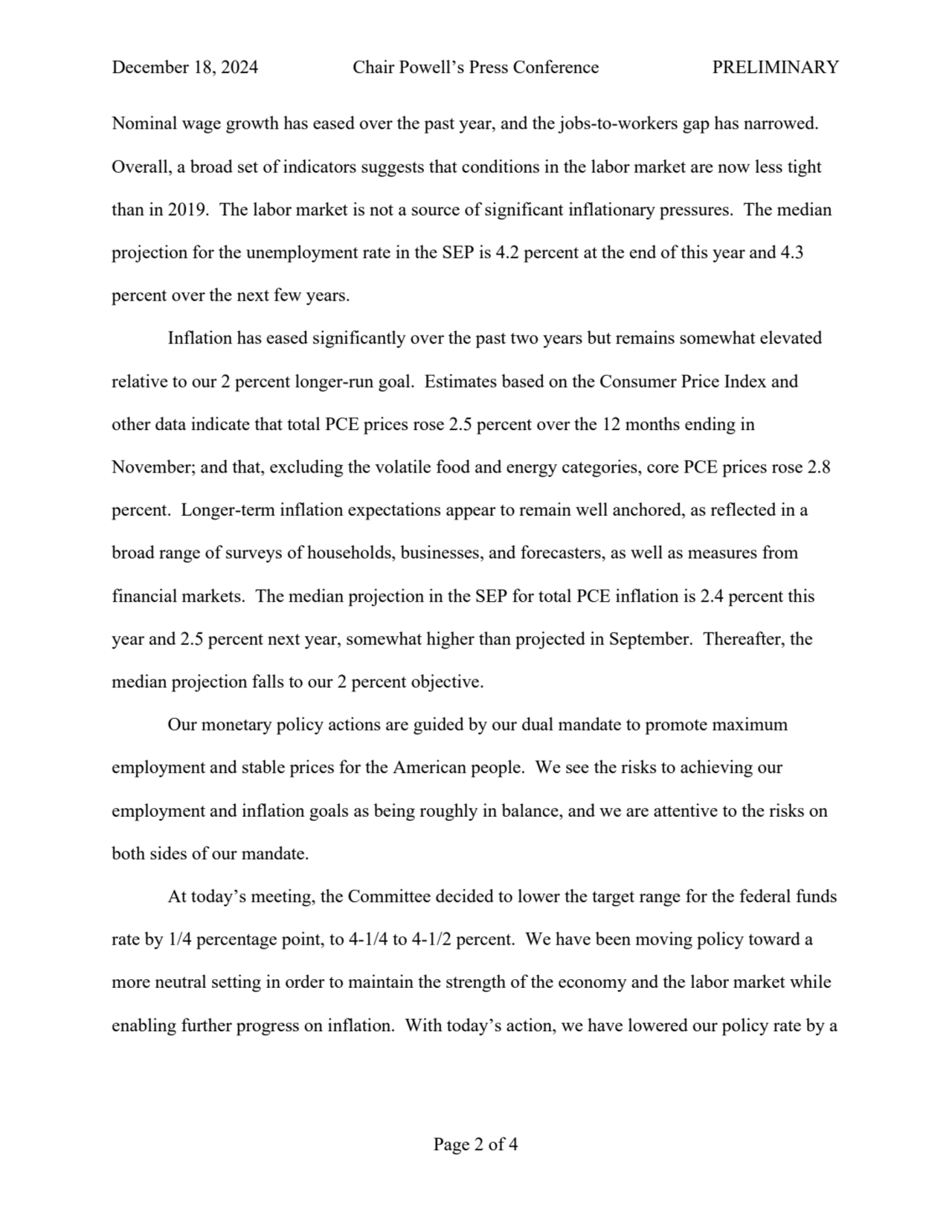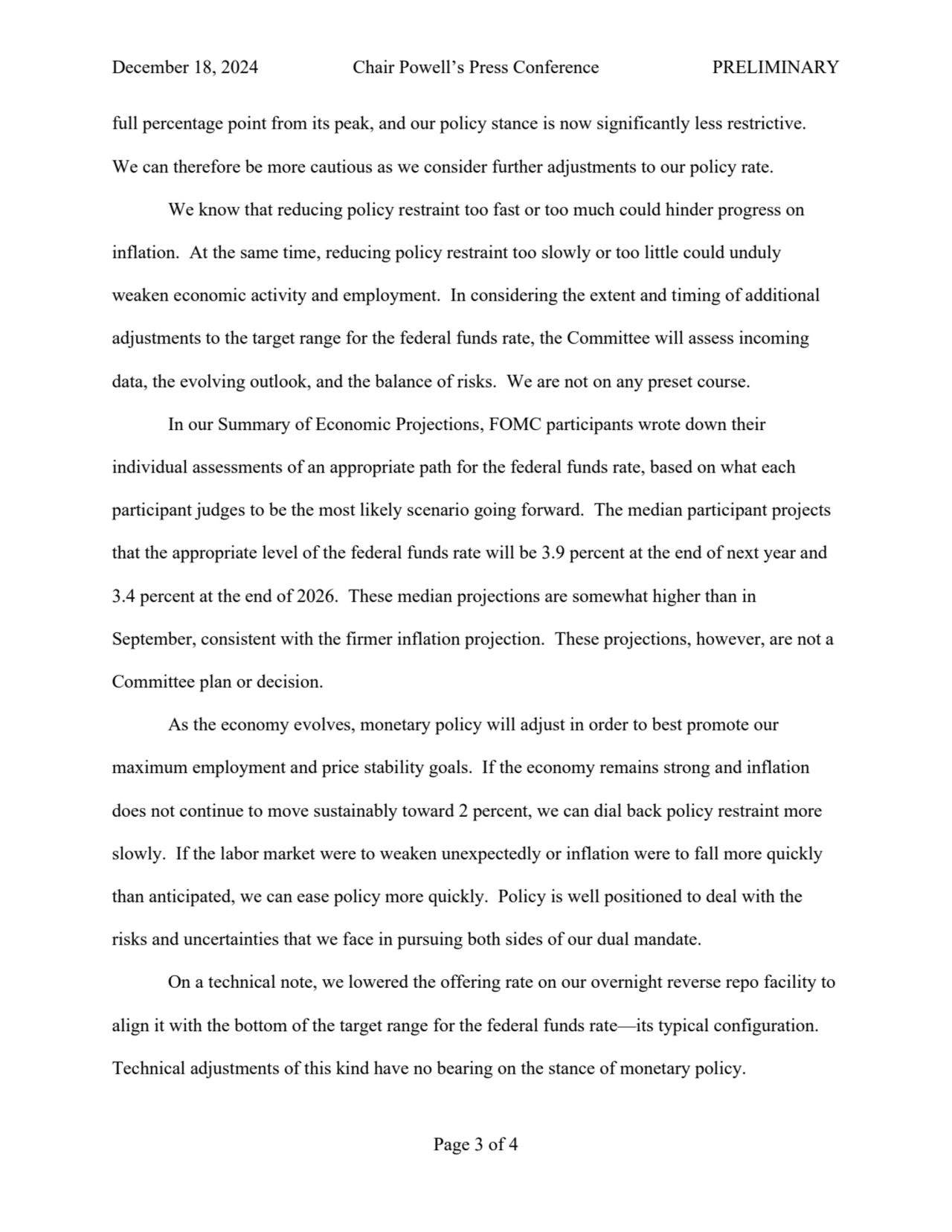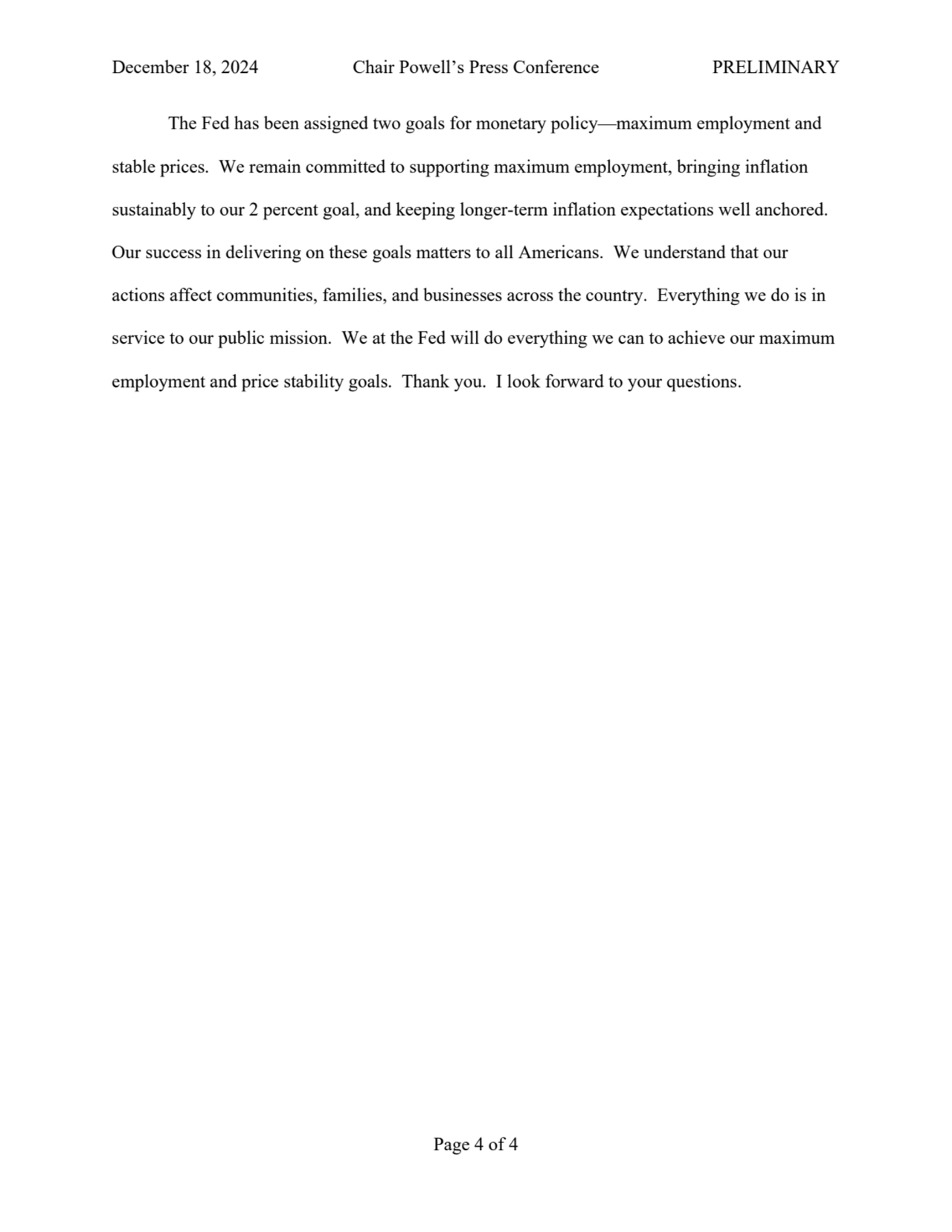Transcript of Chair Powell’s Press Conference - December 18, 2024
 AI Summary
AI Summary
Key Insights
- The Fed remains focused on achieving maximum employment and stable prices.
- The economy is strong, with progress made in the labor market and inflation moving closer to the 2% goal.
- The Federal Open Market Committee decided to lower the policy interest rate by 1/4 percentage point and will continue to reduce securities holdings.
- GDP growth is expected to remain solid, with a median projection of about 2% over the next few years.
- Monetary policy will adjust to promote maximum employment and price stability.




Transcript of Chair Powell’s Press Conference - December 18, 2024
- 1. December 18, 2024 Chair Powell’s Press Conference PRELIMINARY Page 1 of 4 Transcript of Chair Powell’s Press Conference Opening Statement December 18, 2024 CHAIR POWELL. Good afternoon. My colleagues and I remain squarely focused on achieving our dual mandate goals of maximum employment and stable prices for the benefit of the American people. The economy is strong overall and has made significant progress toward our goals over the past two years. The labor market has cooled from its formerly overheated state and remains solid. Inflation has moved much closer to our 2 percent longer-run goal. We are committed to maintaining our economy’s strength by supporting maximum employment and returning inflation to our 2 percent goal. To that end, today, the Federal Open Market Committee decided to take another step in reducing the degree of policy restraint by lowering our policy interest rate by 1/4 percentage point. We also decided to continue to reduce our securities holdings. I will have more to say about monetary policy after briefly reviewing economic developments. Recent indicators suggest that economic activity has continued to expand at a solid pace. GDP rose at an annual rate of 2.8 percent in the third quarter, about the same pace as in the second quarter. Growth of consumer spending has remained resilient, and investment in equipment and intangibles has strengthened. In contrast, activity in the housing sector has been weak. Overall, improving supply conditions have supported the strong performance of the U.S. economy over the past year. In our Summary of Economic Projections, Committee participants generally expect GDP growth to remain solid, with a median projection of about 2 percent over the next few years. In the labor market, conditions remain solid. Payroll job gains have slowed from earlier in the year, averaging 173 thousand per month over the past three months. The unemployment rate is higher than it was a year ago, but at 4.2 percent in November, it has remained low.
- 2. December 18, 2024 Chair Powell’s Press Conference PRELIMINARY Page 2 of 4 Nominal wage growth has eased over the past year, and the jobs-to-workers gap has narrowed. Overall, a broad set of indicators suggests that conditions in the labor market are now less tight than in 2019. The labor market is not a source of significant inflationary pressures. The median projection for the unemployment rate in the SEP is 4.2 percent at the end of this year and 4.3 percent over the next few years. Inflation has eased significantly over the past two years but remains somewhat elevated relative to our 2 percent longer-run goal. Estimates based on the Consumer Price Index and other data indicate that total PCE prices rose 2.5 percent over the 12 months ending in November; and that, excluding the volatile food and energy categories, core PCE prices rose 2.8 percent. Longer-term inflation expectations appear to remain well anchored, as reflected in a broad range of surveys of households, businesses, and forecasters, as well as measures from financial markets. The median projection in the SEP for total PCE inflation is 2.4 percent this year and 2.5 percent next year, somewhat higher than projected in September. Thereafter, the median projection falls to our 2 percent objective. Our monetary policy actions are guided by our dual mandate to promote maximum employment and stable prices for the American people. We see the risks to achieving our employment and inflation goals as being roughly in balance, and we are attentive to the risks on both sides of our mandate. At today’s meeting, the Committee decided to lower the target range for the federal funds rate by 1/4 percentage point, to 4-1/4 to 4-1/2 percent. We have been moving policy toward a more neutral setting in order to maintain the strength of the economy and the labor market while enabling further progress on inflation. With today’s action, we have lowered our policy rate by a
- 3. December 18, 2024 Chair Powell’s Press Conference PRELIMINARY Page 3 of 4 full percentage point from its peak, and our policy stance is now significantly less restrictive. We can therefore be more cautious as we consider further adjustments to our policy rate. We know that reducing policy restraint too fast or too much could hinder progress on inflation. At the same time, reducing policy restraint too slowly or too little could unduly weaken economic activity and employment. In considering the extent and timing of additional adjustments to the target range for the federal funds rate, the Committee will assess incoming data, the evolving outlook, and the balance of risks. We are not on any preset course. In our Summary of Economic Projections, FOMC participants wrote down their individual assessments of an appropriate path for the federal funds rate, based on what each participant judges to be the most likely scenario going forward. The median participant projects that the appropriate level of the federal funds rate will be 3.9 percent at the end of next year and 3.4 percent at the end of 2026. These median projections are somewhat higher than in September, consistent with the firmer inflation projection. These projections, however, are not a Committee plan or decision. As the economy evolves, monetary policy will adjust in order to best promote our maximum employment and price stability goals. If the economy remains strong and inflation does not continue to move sustainably toward 2 percent, we can dial back policy restraint more slowly. If the labor market were to weaken unexpectedly or inflation were to fall more quickly than anticipated, we can ease policy more quickly. Policy is well positioned to deal with the risks and uncertainties that we face in pursuing both sides of our dual mandate. On a technical note, we lowered the offering rate on our overnight reverse repo facility to align it with the bottom of the target range for the federal funds rate—its typical configuration. Technical adjustments of this kind have no bearing on the stance of monetary policy.
- 4. December 18, 2024 Chair Powell’s Press Conference PRELIMINARY Page 4 of 4 The Fed has been assigned two goals for monetary policy—maximum employment and stable prices. We remain committed to supporting maximum employment, bringing inflation sustainably to our 2 percent goal, and keeping longer-term inflation expectations well anchored. Our success in delivering on these goals matters to all Americans. We understand that our actions affect communities, families, and businesses across the country. Everything we do is in service to our public mission. We at the Fed will do everything we can to achieve our maximum employment and price stability goals. Thank you. I look forward to your questions.